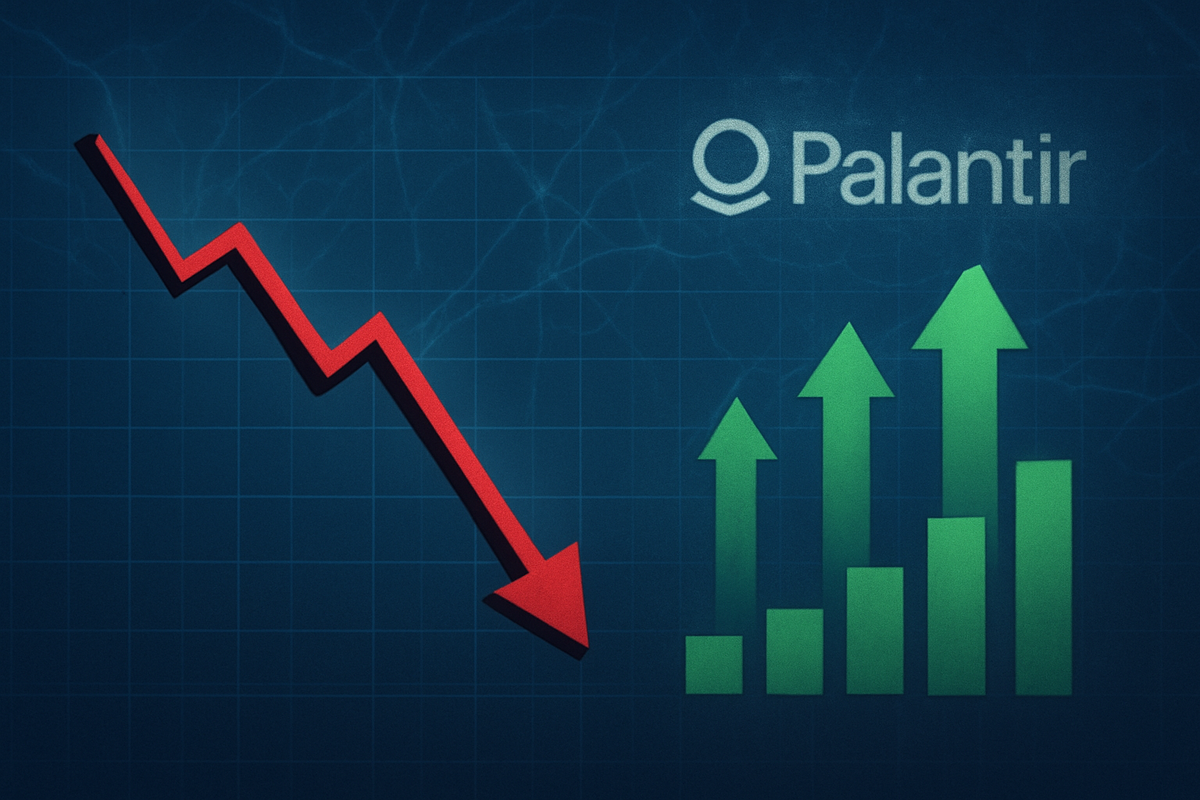
Denver, CO – November 4, 2025 – In a move that sent ripples through the technology sector, Palantir Technologies (NYSE: PLTR) saw its shares tumble by approximately 7% in premarket trading on November 3, 2025, and continued to slide in after-hours trading, despite reporting a robust "beat and raise" third-quarter earnings report. The data analytics giant exceeded analyst expectations across revenue and earnings per share and significantly raised its full-year guidance, a performance that would typically send a stock soaring. This perplexing disconnect between strong fundamentals and a negative market reaction is prompting a re-evaluation of investor sentiment towards high-flying artificial intelligence (AI) stocks, suggesting that the era of rewarding growth at any cost may be drawing to a close.
The immediate implications are significant for Palantir and the broader AI market. The sell-off, occurring on the heels of impressive financial results, underscores a growing investor skepticism regarding sky-high valuations and the sustainability of current growth trajectories in the AI space. It signals that even companies demonstrating exceptional performance are now being subjected to intense scrutiny, with market participants demanding more than just strong numbers to justify elevated price-to-earnings multiples.
The Unraveling of Expectations: A Deep Dive into Palantir's Q3 2025 Performance and Market Reaction
Palantir's third-quarter 2025 earnings report, released after the close of U.S. markets on Monday, November 3, 2025, painted a picture of impressive operational success. The company announced Q3 2025 revenue of $1.181 billion, a substantial 63% year-over-year increase, comfortably surpassing Wall Street's consensus estimate of $1.09 billion. Adjusted Earnings Per Share (EPS) stood at $0.21, significantly beating analyst predictions of $0.17 per share. Furthermore, Palantir raised its full-year 2025 revenue guidance to between $4.396 billion and $4.400 billion, an increase from its prior forecast and well above analyst expectations, projecting a robust 53% year-over-year growth.
Despite these seemingly stellar figures, Palantir's stock, which had surged over 170% year-to-date leading into the report, plummeted. Initial after-hours trading saw the stock fall by approximately 2.9%, with premarket trading on November 4, 2025, witnessing a more significant drop of around 7%. This immediate and sharp decline baffled many, as the company's management, including CEO Alex Karp, presented an optimistic outlook, highlighting strong demand for its Artificial Intelligence Platform (AIP) and significant traction in its U.S. commercial sector.
The primary culprit cited by analysts for this paradoxical reaction was Palantir's exorbitant valuation. Trading at over 90 times forward earnings and roughly 25 times forward sales prior to the earnings call, the market had already priced in exceptional, almost flawless, growth. Investors, having driven the stock to such heights, were evidently looking for something more than just a "beat and raise"—perhaps an even larger guidance increase, a more aggressive expansion into new markets, or a clearer path to sustained, hyper-growth beyond its current large government and U.S. commercial contracts. Concerns were also raised about the more muted free cash flow guidance raise compared to previous quarters and potential concentration risks within its growth profile, particularly a "stagnant" international performance compared to robust U.S. commercial growth. Some market observers even hinted at the "greater fool theory hitting a ceiling," suggesting that the pool of investors willing to buy at increasingly elevated prices might be shrinking.
Shifting Tides: Winners and Losers in a Re-evaluated AI Landscape
The market's reaction to Palantir's (NYSE: PLTR) earnings report signals a critical juncture for AI-focused companies. While Palantir itself demonstrated strong operational performance, the stock's tumble positions it as a short-term loser in terms of investor confidence and market capitalization. The company will now face increased pressure to not only deliver on its raised guidance but also to articulate a compelling narrative that justifies its premium valuation in a more skeptical environment. This might involve demonstrating broader market penetration, diversifying its revenue streams beyond its core government contracts, and proving the long-term scalability of its AIP platform.
The implications extend far beyond Palantir. Other AI pure-play companies, especially those with high valuations and aggressive growth projections, could also be perceived as potential losers. Companies like C3.ai (NYSE: AI), UiPath (NYSE: PATH), and Snowflake (NYSE: SNOW), which have seen their valuations swell on the back of AI enthusiasm, may find themselves under similar scrutiny. Investors are likely to demand a clearer path to profitability, more sustainable growth drivers, and a more conservative valuation multiple. This shift could lead to a broader re-rating of the AI sector, differentiating between companies with strong underlying fundamentals and those whose valuations are primarily driven by speculative fervor.
Conversely, this re-evaluation could create opportunities for more established technology giants that are integrating AI into their existing, profitable businesses. Companies like Microsoft (NASDAQ: MSFT), Google (NASDAQ: GOOGL), and Amazon (NASDAQ: AMZN), with diversified revenue streams and robust balance sheets, might be viewed as safer bets for AI exposure. Their ability to invest heavily in AI research and development without the same pressure to justify hyper-growth valuations could make them more attractive. Additionally, companies providing foundational AI infrastructure, such as semiconductor manufacturers like NVIDIA (NASDAQ: NVDA), might continue to thrive as the underlying demand for AI compute remains strong, regardless of individual application valuations. The market's newfound emphasis on sustainable growth and realistic valuations could also benefit value-oriented investors looking for AI exposure at more reasonable prices.
Beyond the Numbers: Wider Implications for the AI Industry and Market Trends
Palantir's post-earnings stock decline, despite a strong report, is not an isolated incident but rather a significant indicator of broader industry trends and a maturing AI market. For months, the AI sector has been characterized by exuberant valuations, with investors pouring capital into companies promising transformative technologies. This event suggests that the market is entering a new phase, where the initial hype is giving way to a demand for tangible results, sustainable business models, and realistic growth trajectories. It signifies a shift from a "growth at any cost" mentality to one that prioritizes profitability, free cash flow, and defensible competitive advantages.
The ripple effects could be substantial. Competitors within the data analytics and AI software space will undoubtedly take note, potentially adjusting their own investor communications and strategic planning to emphasize profitability and valuation discipline. Partnerships in the AI ecosystem might also be re-evaluated, with greater scrutiny on the financial health and long-term viability of collaborators. On a broader scale, this event could contribute to a sector-wide correction or "cooling off" period for AI stocks, similar to previous tech bubbles. While not necessarily a crash, it suggests that the rapid ascent of many AI companies might be unsustainable without a clear demonstration of long-term value creation.
Historically, such market corrections are not unprecedented. The dot-com bubble of the late 1990s and early 2000s serves as a powerful precedent, where companies with innovative technologies but unsustainable business models saw their valuations collapse. While the current AI landscape is vastly different, with more established revenue streams and clear technological advancements, the underlying principle of investor sentiment catching up to over-inflated expectations remains relevant. Regulatory bodies might also begin to pay closer attention to valuation practices and transparency within the AI sector, especially if widespread investor losses become a concern. The event underscores the cyclical nature of market enthusiasm and the eventual return to fundamental analysis, even for the most cutting-edge technologies.
What Comes Next: Navigating a More Scrutinizing AI Market
In the short-term, Palantir (NYSE: PLTR) will likely face continued pressure to demonstrate that its robust U.S. commercial growth and AI Platform (AIP) adoption can translate into sustained, profitable expansion that justifies its valuation. The company may need to focus more explicitly on metrics like customer acquisition costs, churn rates, and the long-term value of its contracts, rather than just top-line growth. Strategic pivots could involve a more aggressive push into international markets to diversify its growth profile or a clearer articulation of its competitive moat against emerging AI solutions from tech giants. For the broader AI market, the immediate future may see a period of increased volatility and differentiation. Investors will likely become far more selective, favoring companies with strong balance sheets, clear paths to profitability, and proven market traction over those purely reliant on speculative growth.
Looking further ahead, the long-term possibilities for Palantir remain strong, provided it can adapt to this new investor landscape. Its proprietary data integration and AI capabilities are highly valued by both government and commercial clients. The challenge will be to scale these capabilities efficiently and profitably, ensuring that revenue growth is accompanied by expanding margins and free cash flow. This might involve refining its sales strategies, optimizing its deployment processes for AIP, and potentially exploring strategic acquisitions that complement its core offerings. For the AI sector as a whole, this period of re-evaluation could ultimately be healthy, weeding out weaker players and forcing a greater focus on sustainable innovation and value creation.
Market opportunities may emerge for astute investors willing to identify undervalued AI companies or those with strong fundamentals that have been unfairly penalized by the broader sector downturn. Conversely, the challenges will involve navigating increased regulatory scrutiny, potential talent wars, and the ever-evolving technological landscape. Potential scenarios range from a continued, gradual correction in AI valuations to a more pronounced "flight to quality" within the sector. Investors should closely watch for Palantir's subsequent earnings reports, particularly its free cash flow generation and international growth, as well as broader market trends in AI investment and the performance of key competitors. The coming months will be crucial in determining whether this event was a temporary blip or a harbinger of a more fundamental shift in the AI investment paradigm.
A New Era for AI Valuations: Key Takeaways and Future Outlook
Palantir's (NYSE: PLTR) recent stock performance, where a "beat and raise" quarter was met with a significant market sell-off, serves as a pivotal moment for the artificial intelligence sector. The key takeaway is clear: the market's tolerance for sky-high valuations, fueled purely by growth narratives, is diminishing. Investors are now demanding a more rigorous assessment of fundamentals, profitability, and sustainable long-term value, even from companies at the forefront of technological innovation. This event underscores that while AI remains a transformative force, the investment landscape around it is maturing, moving beyond speculative enthusiasm towards a more discerning approach.
Moving forward, the market is likely to exhibit increased caution and selectivity within the AI space. Companies that can demonstrate a clear path to consistent profitability, robust free cash flow generation, and a defensible competitive moat will likely be rewarded. Conversely, those with inflated valuations and less clear business models may continue to face downward pressure. This shift is not necessarily a negative for the AI industry itself, but rather a necessary recalibration that could lead to a healthier, more sustainable growth trajectory in the long run. It will force companies to focus more acutely on operational efficiency and customer value.
The lasting impact of this event could be a re-anchoring of valuation multiples across the AI sector, bringing them more in line with established software and technology companies. Investors should watch for several indicators in the coming months: Palantir's ability to maintain its growth momentum while improving profitability, the performance of other high-valuation AI stocks, and any significant shifts in venture capital funding for AI startups. This period will ultimately differentiate the truly transformative AI businesses from those that merely rode the wave of hype, shaping the next chapter of innovation and investment in artificial intelligence.
This content is intended for informational purposes only and is not financial advice






